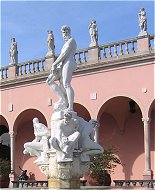Fountain of OceanusMuseum Label: Subject info: |
Boboli Gardens
THE NEPTUNE FOUNTAIN 1568
In the center of a large basin that now occupies the whole width of the terrace,
Neptune stands on a rock, aiming with his trident at a fish, while sea deities hide in the
hollows. At the present time there are several grass terraces above the basin in a sort of
amphitheatre, But the fountain terrace must have been larger originally, so that it might
have round it sweet-scented flowers in beds, and clipped shrubs to make a pleasant
setting. On the hill behind, and visible from the palace, was a niche showing the Medici
arms. Water flowed from pipes in the dividing wall, between projections, into a canal
where twelve stone dogs stood on guard. In the year 1638 the rising ground was topped at
the town wall by a statue of Plenty standing in a green alcove.
According to Vasari, at the time of Francesco’s marriage festivities in 1566,
"the very large gardens were adorned with innumerable statues both old and new, as
well as many streams.” But from this observation we do not learn when it was that the
enlargement of the garden, below the west side of the hill towards the Porta Romana, took
place. The fortified town wall limited the extension in the main axis, and so it had to be
shaped to a right angle alongside the western wall, and the ground showed a wedge shape
towards the Porta Romana. In this part of the garden terraces have been left out entirely,
and the main axis is marked, in Florentine fashion, by an imposing cypress avenue (Fig.
221), which at first was full of statues.
The Boboli Garden, was laid out by the Medici family behind the Palazzo Pitti, their
Florentine home in northern Italy. The history of the Pitti Palace is a tangled tale, but
the accounts we have of the Boboli Gardens are so meagre that it is very difficult to
arrange them even chronologically. In 1549 the proud Spanish Princess Eleonora de Toledo,
wife of Cosimo I bought the palace from a great-grandson of Luca Pitti, its original
founder. The middle section stood already with seven windows in the width of it, but the
present court and the garden fa ade did not exist. Eleonora seems to have begun the
laying-out of the Boboli Gardens without delay, for she sent Tribolo (who was busy with
the work at Castello) to Elba to fetch away a huge block of granite, twelve braccia (six
metres) in diameter, to make the basin of the fountain of the Prato at the Pitti Palace;
and according to Vasari, Tribolo also made the whole plan of the hill site, as it still
is, arranging everything with excellent judgment in its own particular place, though a few
things have been altered since.
After his return from Elba in 1550 Tribolo died, so the work was carried out by others. In
consequence of his death not only was the completion of Castello held up, but all the work
at the Pitti Palace and Boboli Gardens was delayed. It was not till 1558 that Ammanati
began energetically on the court and the garden fa ade.
https://www.gardenvisit.com/got/7/9.htm
